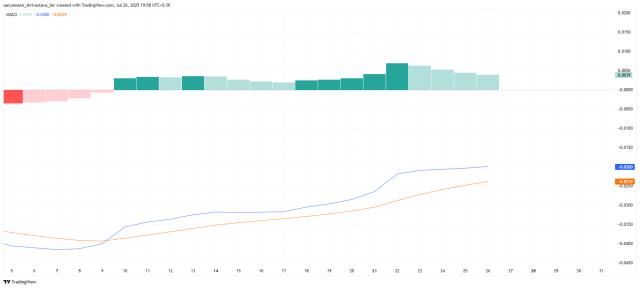As the US dollar continues to weaken and the US Treasury market experiences turbulence, Bitcoin first broke through the $111,000 mark on May 22, 2025, and subsequently set a new historical high of $112,000. This rise pushed the total cryptocurrency market value to $3.6 trillion, with institutional funds continuously flowing into spot ETFs, attracting $609 million in a single day and accumulating over $2 billion in six consecutive days. Analyst W noted that the current BTC price has reached 118,000.52 USDT, indicating strong market momentum.
US Dollar Weakens! Bitcoin Breaks $111,000 as US Treasury Auction Chaos Triggers Market Volatility
With Bitcoin breaking the $111,000 mark for the first time, the US dollar continues to weaken, and spot ETFs absorb $609 million in fund inflows. Political instability in Washington and a disastrous 20-year Treasury bond auction have exacerbated the dollar's decline, driving yields to a new high of 5.127% since November 2023.
The foreign exchange market reacted strongly to the failed $16 billion debt auction, with the euro jumping 0.4% to 1.1334 dollars and the Japanese yen simultaneously strengthening. The bond market turmoil shows a diminishing interest from international investors in US debt, creating a tailwind for cryptocurrencies as a hedge against traditional financial volatility.
Bitcoin Reaches Historic High of $112,000 Driven by Institutional Demand
Bitcoin surged to a record $112,000 on May 22, with a daily increase of 4%, entering a new price discovery phase. This rally pushed the total cryptocurrency market value to $3.6 trillion, though still below the peak of $3.9 trillion on December 3, as Altcoins underperformed.
Continuous institutional accumulation drives market momentum, with US spot Bitcoin ETFs recording over $2 billion in fund inflows for six consecutive days. Enterprises and funds are actively hoarding BTC, driving a 17% increase year-to-date and a 47% rebound from the April low of $75,000.
Bitcoin Experiences Unprecedented Stable Fund Inflows, Continuous Institutional Accumulation
Crypto analyst Willy Woo observed historically stable Bitcoin fund inflows, reflecting the disciplined investment strategy of institutional investors. Billions of dollars are flowing into the market through the dollar-cost averaging method common in traditional asset classes.
This trend indicates the increasing maturity of the cryptocurrency market, with professional investors viewing Bitcoin as a macro asset rather than a speculative tool. In a macroeconomic volatile environment, this continuous demand may strengthen the narrative of BTC as a store of value.
B² Network Launches Mining Squared to Achieve Automated BTC Yield Strategies
B² Network officially launched Mining Squared, a DeFi yield aggregation platform providing automated yield strategies for Bitcoin miners and holders. The product offers 2%-5% annual BTC returns through miner binding or wallet balance auto-subscription, requiring no manual management.
The platform plans to expand further into CeFi and RWA products, continuously extending Bitcoin's application scenarios. This development marks the maturation process of BTC in three key areas: infrastructure, financialization, and smart ecosystem evolution.
Wall Street Veteran Analyzes Bitcoin's Role in Modern Macro Strategies
Macro strategy investment expert Jordi Visser, with thirty years of Wall Street experience, challenged traditional economic wisdom in a recent interview. In the current market structure, traditional economic recession definitions no longer apply, and Bitcoin is gaining institutional recognition as a non-correlated asset class.
The continuous devaluation of fiat currency seems inevitable, driving demand for alternative value storage. Retail investors and independent capital now have unprecedented market influence, often moving contrary to institutional expectations. This paradigm shift coincides with increasing cryptocurrency acceptance in traditional investment portfolios.
Market dynamics indicate recognition of Bitcoin's hedging characteristics during monetary instability. The so-called "Fed put" - market expectations of central bank intervention - may be losing effectiveness, prompting investors to seek decentralized alternatives. This transformation reflects deeper structural changes in the global financial system, rewarding asymmetric bets and non-traditional assets.
Michigan Legislators Propose Cryptocurrency Bill Including Bitcoin Retirement Investment and Mining Incentives
Michigan legislators proposed four cryptocurrency-focused bills, demonstrating gradual institutional acceptance of digital assets. The legislative proposal includes allowing public retirement funds to gain Bitcoin exposure through regulated ETFs, directly challenging federal government resistance to cryptocurrencies in retirement accounts.
HB 4510 opens doors for state retirement systems to allocate Bitcoin through exchange-traded products, emulating the treasury strategies of companies like MicroStrategy and Tesla. Simultaneously, HB 4511 draws clear lines to prevent potential Central Bank Digital Currency (CBDC) overexpansion, prohibiting state government agencies from facilitating or promoting digital dollars.
The bill package includes innovative environmental provisions. HB 4512 and 4513 offer tax incentives for converting abandoned oil wells into Bitcoin mining sites, combining energy policy with cryptocurrency infrastructure development. This approach follows successful pilot programs in North Dakota and Texas.






